How to Start Soloing With Chord Tones - chord tone improvisation on "Fly Me To The Moon"
Aug 02, 2022In this lesson I demonstrate soloing over Fly Me To The Moon using ONLY chord tones and talk about how to get started with this essential skill.
→ FREE Arpeggio Shapes Pack for Targeting Chord Tones when Soloing
Chord Tone Soloing Video Outline
0:00 - Intro (what do Bach and jazz have in common?)
1:29 - Video outline
2:18 - Demonstration of soloing over "Fly Me to the Moon" with chord tones only
3:53 - Commentary
4:48 - How to get started
6:44 - Playing with just two strings
8:34 - Step-by-step practice for chord tone soloing
11:03 - Final step
11:53 - Arpeggio shapes pack (free download)
12:32 - Outro
Links & Lessons Mentioned in this Chord Tone Soloing Video
- Autumn Leaves chord tone improv video
- Phrasing lesson
- Chord tone arpeggio playlist series (12 chord types)
- Free chord tone arpeggio pack download
Chord Tone Soloing Lesson Description
In my opinion, being able to improvise over chord progressions using JUST chord tones is the gateway skill to being able to improvise anything.
A few weeks ago I published a lesson on this topic, but I didn't quite break down how to start working on it from the ground up.
In this video I use the song "Fly Me to the Moon" and I lay out a crystal clear process for how to start improvising with chord tones at any skill level.
If you want to improvise over progressions then this is one of the very best things you can work on.
What Do Bach and Jazz Have in Common?
I once had a classical music composition teacher who always said, “If you can compose a bach chorale then you can compose anything.”
The Bach chorales are a masterful series of four-part choral pieces that Johann Sebastian Bach composed, and they are used as a staple and a foundation for studying classical music theory, composition, voice leading, and counterpoint.
All over the world this is what people are studying, so this teacher had us study them extensively.
He kept saying, “If you can compose a Bach chorale then you can compose anything.”
This is exactly how I feel about chord tone improvisation.
If you can improvise over a chord progression using chord tones only, then you can improvise anything.
In this video I'm going to demonstrate soloing over “Fly Me to the Moon” using only chord tones.
I have another similar lesson on this exact topic, chord tone soloing, on “Autumn Leaves.”
I got a bunch of requests to break down in a more detail how to go about working on this chord tone soloing improvisation skill.
How do I get started?
It can seem really daunting.
It is quite hard, and it does take a long time to to work on, but it is the gateway to being able to improvise anything.
For now we're going to talk about how to get started with this chord tone soloing skill.
Lesson Outline
First, I’m going to explain my video demonstration of soloing over “Fly Me to the Moon” with chord tones only:
- In one fretboard position
- With chord tone arpeggio diagrams (the shapes that I used moment by moment)
Second, I'm going to break how anybody can start doing this from scratch at any level of playing.
If you want a free download of those exact diagrams, check out my chord tone arpeggio vocabulary pack. It has all the chord tone shapes you need for 12 different chords, which you can use to improvise over any chord progression that comes up in jazz or otherwise.
Chord Diagrams
Below is the full chord chart “Fly Me to the Moon,” from the play along app I used, iReal Pro.
Also shown are the chord tone arpeggio shapes I played.
Those are the shapes you can download with my chord tone arpeggio pack.

Amin7
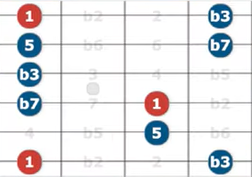
Dmin7
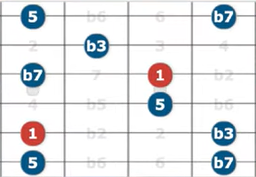
G7
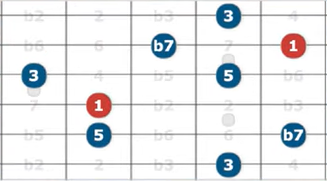
Cmaj7
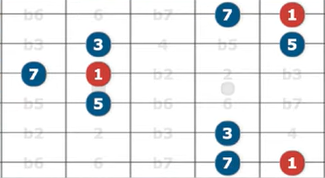
Fmaj7
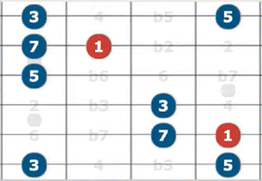
Bmin7b5
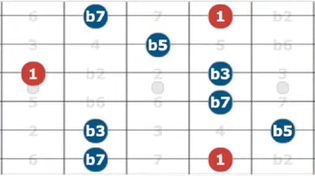
E7

A7

Chord Tone Soloing is a Foundation
It's not supposed to be the most amazing thing.
It is supposed to be a foundation and a starting point.
Most importantly, it’s a skill to hear every chord, get it in your ears, and to see and feel the “good notes” of every chord - the actual chord tones.
Around that you can start to do anything that you want.
It's really hard to get used to switching between the collection of notes for each chord as they go by, but once you get used to being able to do that with any two chords and any two shapes, you'll be able to apply that to learning new shapes, new chords, or anything you want.
One of the secrets for me is that I'm staying in one position and i'm following voice leading as much as possible.
In the video, you can see and hear that I moved by step, half step, or whole step, connecting between the chords to find nice built-in melodies.
How to Get Started with Chord Tone Soloing
This can be so daunting.
The first thing I want to recommend and show you and then after this I'll break down in very detail step by step how to get started from scratch.
The first thing I'm going to show you is: thinking on one or two strings at a time in, one position, with our shapes (the notes that you're going to play within each chord) really planned out.
For each A minor seven chord, I'm gonna play on strings four and three (the middle two strings) in the fourth, fifth, or sixth position, depending on where the shape lands.
For A minor seven I have these three notes available:

These notes are the root, flat seven, and flat three.
For A minor seven, that first chord, I can only play those.
On the same two strings when the next chord comes along, what are my notes on D minor seven?

I have the fifth, flat seven, and the root.
I can only play those.
How about G seven? Same two strings.

How about C major 7?
I can only play the following.

I’m planning my shapes and then I'm going to drill, drill, drill like crazy, improvising with only those available notes.
You can just do four measures at a time or two measures at a time.
Try to work towards the whole tune that way.
I played with just the highlighted middle two strings only.
To make it sound musical I really thought about phrasing.
I did a video on phrasing recently because that's really what brings melodies to life.
These two things - phrasing and working on chord tone improvisation are almost everything we need to make great music and have control over our playing.
I strictly to just those notes I've mapped out for you and showed you and tried to do something musical with it.
Combined with phrasing you can become so intentional with things.
You can remember many measures ago or many ideas ago exactly what you played because you have such control over what you’re drawing from and what the method is.
Step-By-Step Practice for Chord Tone Soloing
So what's the really really step-by-step process for how to do this?
Step 1) Choose a song.
Step 2) Choose a position to play in. You're gonna play as close to that position as you can with every shape that comes up.
Step 3) Find the chord tone arpeggio shapes from my chord tone vocabulary pack that corresponds to the first four chords in that position.
If you can map these out on your own, totally fine, but if you want to use the resource that I made, use that.
Step 4) Choose two adjacent strings to play on.
Here's the part to really dig into, drilling and practicing.
You can't just jump in and do it.
This exercise is amazing.
Play out of time eight notes per measure and play chord tones only.
If you play your progression that way, you can count one to eight or count “one and two and three and four and.”
When you change chords, try to connect to the closest possible note you can from where you were.
So you're finding those connecting spots and you're reviewing eight notes per chord.
Practice that until you can do it in time at any tempo.
You're improvising although there's not much to do, but that's the point of the exercise.
It keeps you playing constant notes in time with voice leading.
You're mapping out your vocabulary.
The next step is to do exactly that with phrasing until you feel like you can make it sound musical.
Final Step
The last step is that you repeat that process on other string sets and other groups of measures.
You just repeat and practice, practice, practice until you're able to play through the entire song on all six strings with chord tones only in one fretboard position.
Then with phrasing, and at that point you're doing exactly what I demonstrated in the video
And from there like I said at the beginning, you can really take it anywhere - any method, anybody's crazy improvisation stuff works on top of this ability and this knowledge.
Supplementary Material
Check out my chord tone arpeggio series to get some advice on how you can add chromatic notes and make it weirder by playing around the chord tones.
I have a video for all 12 chord types and all of them go over the same thing but it shows how to play outside of the notes as well.
Also check out that “Autumn Leaves” chord tone improvisation lesson for some advice on that too.
As I already said, download my chord tone arpeggio pack for free!
I made that for you to help with mapping out that vocabulary.
That's a resource I wish I had when I was mapping it out from scratch originally.
I hope you feel that that's beneficial.
Outro
With the way we broke it down today in this lesson, there's no excuse.
Anybody can get started working on this.
Yeah it's going to take a long time, yeah it's hard, yeah it should be a brain buster.
Little by little by little.
When I started doing this it literally felt impossible.
This is not something anyone can just do.
It's only people that practiced it that can do it, so take your time and slowly start getting there IF you know that that's the direction you want to go with your playing.
Let me know in the comments anytime how this practicing is going for you.
I post a new lesson every week.
Next week's lesson is on harmonizing a one-note-melody with 12 different chords.
It’s half reharmonization and half cool composition and harmony lesson.
Hope to see you there!
Thanks for watching, take care, and happy practicing!
Like my video lessons?
I’ll send you an email when they come out each Tuesday
Just sign up here
I never spam or share your info

